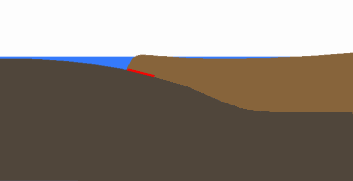
Introduction (Click here to a MSWord version of this page)
What is an earthquake?
Underneath the earth, there is stored elastic energy that suddenly releases. This release is caused by sudden fractures or breaks between rocks. Along where these movements occur is called a fault. Some of the energy released is in the form of vibrations, which are called seismic waves. These vibrations are called earthquakes. Earthquakes occur along faults because they are weak zones in the rock. The only known seismically active surface faults in British Columbia are beneath the ocean off the west coast.
The surface of the earth is made up of about a dozen large plates and several smaller ones that are constantly moving. The movements are very slow - only a few centimetres each year. When the plates rub against one another, strain builds up, especially at the edges. When the strength of the rock is exceeded, the earth's crust may suddenly shift by several metres causing an earthquake.
There are many types of earthquakes. Most recorded earthquakes are caused by stress accumulation within the plates. In BC and offshore earthquakes have occurred either within the Juan de Fuca or the North American plates. None have occurred along the junction where the two plates are actually in contact. The apparent inactivity within the zone of contact between the plates suggests that either the plates are locked together and are accumulating strain or that the contact zone is well lubricated and the plates are moving smoothly past each other. This stress accumulation can result in a potentially very destructive type of earthquake, called a megathrust earthquake (see figure 1.1).

Figure 1.1 (Source: http://www.equakealert.com/megathrust.htm)
Why are earthquakes important to the province of British Columbia?
There is strong evidence that much larger earthquakes (Richter scale 8 to 9) have occurred beneath the continental slope and shelf off the west coast in the more distant past. These “great” quakes originate on the 1000 km long thrust fault that separates the Juan de Fuca and North America plates, in what is known as the Cascadia subduction zone. A magnitude 9 earthquake releases approximately 30 times the energy of a magnitude 8 event. Should the entire Cascadia subduction zone release during a magnitude 9 event, all cities in western Oregon, western Washington, and southwestern British Columbia might be affected. Vancouver, Seattle, and Portland are fortunate that the earthquake-generating portion of the subduction zone is located offshore and extends little if at all beneath the coast. However, shaking would decrease slowly with distance inland, and the hazard to these cities is considerable, even though they are 100 to 200 km from the source. The intensity of strong shaking in the frequencies that most structures are sensitive would last perhaps several minutes. In addition, the energy spectrum of a subduction earthquake would have seismic waves with relatively long periods that might be especially damaging to some taller buildings.
Some people question the value of spending large sums of public money preparing for a damaging earthquake. However, the devastation wrought by the Kobe earthquake, which result in 5470 deaths and damage of $200-300 billion Canadian dollars in a country widely acknowledged to have the highest level of earthquake preparedness in the world, provides a timely reminder of the need for a coordinated and well funded plan to assess hazard and reduce structural damage and loss of life due to a strong earthquake in southwestern British Columbia.
Richter scale was developed by Charles Richter, a measure of the size (magnitude) of an earthquake. It is estimated from the amplitude of the seismic waves that are recorded by sensitive instruments called seismographs. This can be used to estimate the energy released at the focus. The Richter scale is logarithmic, so that each whole number represents a tenfold increase in recorded amplitude. A magnitude of 7.0, for example, indicates measured amplitudes that are ten times greater than those of magnitude 6.0 and 100 times greater than those of magnitude 5.0. To experience an earthquake with sound effects, click here.You will understand the types of waves with this Activity.
Back to Earthquake Math Trail Home